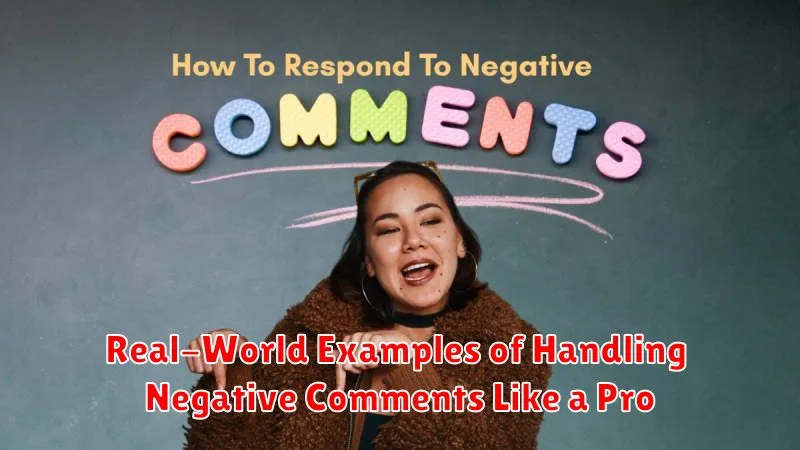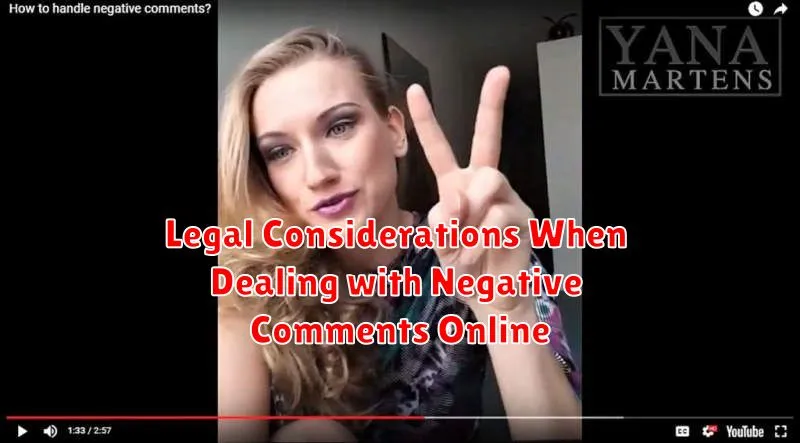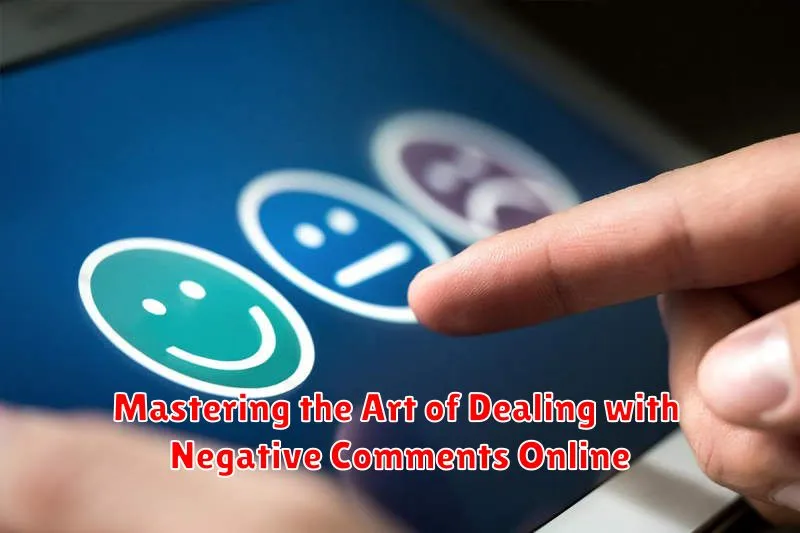In today’s digitally driven world, navigating the online landscape can be both rewarding and challenging. Negative comments are an unavoidable aspect of online presence, whether you’re a business owner managing a brand’s social media, a content creator sharing your work, or simply an individual engaging in online discussions. Mastering the art of dealing with negative feedback is crucial for maintaining a positive online reputation, fostering healthy communities, and protecting your own mental well-being. This article will provide you with effective strategies and practical tips to confidently address negative comments, turning potentially damaging interactions into opportunities for growth and connection.
From understanding the psychology behind online negativity to developing a step-by-step approach for responding to criticism, we’ll explore the essential skills needed to effectively manage negative comments. Learn how to identify different types of negative commenters, from trolls to genuinely concerned customers, and tailor your responses accordingly. Discover the power of constructive engagement, learn when to ignore, delete, or report harmful comments, and ultimately cultivate a resilient online presence. This comprehensive guide will equip you with the tools you need to master the art of dealing with negative comments online, transforming online negativity into a catalyst for positive change.
Understanding the Impact of Negative Comments
Negative comments can have a profound impact on individuals and businesses operating online. Reputation is a key factor affected by negativity. Negative commentary, whether valid or not, can erode trust and credibility, potentially leading to a decline in customers or followers.
Emotional well-being is another critical area impacted. Receiving negative comments can be emotionally taxing, leading to stress, anxiety, and even discouragement, particularly for individuals or small business owners personally invested in their online presence.
Beyond the individual level, negative comments can influence brand perception. Potential customers often research businesses online before making purchasing decisions. A prevalence of negative comments can sway their opinion and ultimately discourage them from engaging with the brand.
Finally, negative comments can impact search engine optimization (SEO). While not a direct factor, negative sentiment surrounding a brand can indirectly affect search rankings. If potential customers are deterred by negative feedback, this can lead to lower engagement and traffic, which search engines may interpret as a negative signal.
Identifying Different Types of Negative Comments
Not all negative comments are created equal. Understanding the nuances of different types of negativity can help you tailor your responses effectively. Identifying the underlying motivation behind a comment is key to choosing the right course of action.
Here are some common categories of negative comments:
- Spam/Trolling: These comments are often irrelevant, inflammatory, and intended to disrupt or provoke. They often lack genuine concern about the topic at hand.
- Genuine Criticism: This type of feedback, while negative, often stems from a place of genuine concern or a desire for improvement. These comments can be valuable if addressed constructively.
- Misunderstandings: Sometimes, negative comments arise from a simple lack of information or a misinterpretation of your message. Clarifying the issue can often resolve the negativity.
- Personal Attacks: These comments are directed at you personally, rather than the topic at hand. They can be abusive, hurtful, and often violate platform community guidelines.
- Unconstructive Complaints: These comments express dissatisfaction without offering specific reasons or suggestions for improvement. They are often vague and difficult to address.
Strategies for Responding to Negative Comments Effectively
Responding to negative comments requires a strategic approach. Do not react impulsively. Take time to assess the comment and formulate a thoughtful response.
Acknowledge and validate the commenter’s concerns, even if you disagree with their perspective. This demonstrates empathy and a willingness to listen.
Offer a solution if the comment highlights a genuine issue. If the complaint is valid, apologize sincerely and explain how you’ll address the problem.
If a comment is abusive or inappropriate, set clear boundaries. Explain that such behavior is unacceptable and, if necessary, delete the comment or ban the user.
Keep your responses concise and professional. Avoid getting into lengthy arguments or engaging in personal attacks.
How to Turn Negative Feedback into Positive Outcomes
Negative feedback, while often unwelcome, presents valuable opportunities for growth and improvement. Instead of viewing it as a personal attack, consider it a source of actionable insights.
One key strategy is to actively solicit feedback. Create easy avenues for customers and users to share their experiences, both positive and negative. This demonstrates a commitment to improvement and allows you to address issues before they escalate.
Analyze the feedback you receive. Look for patterns and recurring themes. Is there a specific product feature consistently receiving complaints? Is there a recurring issue with customer service? Identifying these trends helps prioritize areas for improvement.
Use negative feedback to drive innovation. Customer complaints can highlight unmet needs and inspire creative solutions. Addressing these issues can lead to improved products, services, and overall customer satisfaction.
Finally, demonstrate responsiveness. Publicly acknowledge negative feedback and outline the steps being taken to address the concerns. This builds trust and demonstrates a commitment to accountability.
Building a Strong Online Community and Minimizing Negativity
A thriving online community can significantly reduce the prevalence of negative comments. Proactive engagement fosters a positive environment where members feel valued and respected.
Establish clear community guidelines. Outline acceptable behavior and consequences for violations. This sets expectations and empowers members to uphold positive interactions.
Encourage positive interactions. Actively participate in discussions, respond to comments (both positive and neutral), and highlight exemplary community member behavior. This cultivates a sense of belonging and encourages constructive dialogue.
Moderate consistently. Regular monitoring and enforcement of guidelines are crucial. Swiftly address negative comments and, if necessary, take action such as warnings, temporary suspensions, or permanent bans.
Empower your community members. Encourage them to report inappropriate behavior. This distributes the responsibility of maintaining a positive environment and shows that you value their input.
Measuring the Success of Your Negative Comment Management Strategy
Effectively measuring the success of your negative comment management strategy is crucial to understanding its impact and making improvements. Key Performance Indicators (KPIs) provide quantifiable metrics to track progress and identify areas needing adjustment.
Volume of Negative Comments: Track the overall number of negative comments received over a specific period. A decreasing trend suggests your strategy is effectively mitigating negativity.
Response Time: Measure the time it takes to respond to negative comments. Faster response times demonstrate attentiveness and can diffuse tense situations.
Sentiment Analysis: Employ sentiment analysis tools to gauge the overall tone of comments. A shift towards more positive or neutral sentiment indicates successful management.
Resolution Rate: Track the percentage of negative comments successfully resolved. This involves turning negative experiences into positive ones or at least reaching a mutually acceptable understanding.
Customer Satisfaction (CSAT) Scores: If possible, link comment management to customer satisfaction surveys. Improved CSAT scores, particularly from those who initially left negative comments, signify positive impact.
Real-World Examples of Handling Negative Comments Like a Pro

Examining real-world scenarios can provide valuable insights into effective negative comment management. Let’s explore a few examples:
Example 1: Addressing a Factual Error
A customer posts a negative review claiming a product feature is missing. The company responds politely, acknowledging the comment and clarifying that the feature is indeed present, providing clear instructions on how to access it. This showcases product knowledge and a willingness to help.
Example 2: Responding to Rude or Unreasonable Criticism
An individual leaves a disrespectful and irrelevant comment on a social media post. The company responds calmly and professionally, reiterating their commitment to constructive dialogue but stating that personal attacks will not be tolerated. This sets clear boundaries while maintaining a professional image.
Example 3: Turning a Negative into a Positive
A customer complains about a long wait time for customer service. The company apologizes sincerely, offers a small discount on their next purchase, and explains the steps being taken to improve response times. This transforms a negative experience into an opportunity to demonstrate customer care and build loyalty.
Legal Considerations When Dealing with Negative Comments Online

Navigating the legal landscape surrounding negative comments requires careful consideration. While free speech is protected, there are limitations regarding defamation and harassment.
Defamation involves publishing false statements that harm someone’s reputation. A key element is proving the statement is false and caused demonstrable damage. Online reviews and comments can be subject to defamation laws.
Harassment involves persistent and unwanted online behavior intended to distress or intimidate. Cyberstalking and credible threats of violence are illegal. Distinguishing between robust criticism and targeted harassment is crucial.
Privacy concerns can also arise with negative comments. Revealing sensitive personal information without consent is illegal in many jurisdictions. Exercise caution when responding to comments, ensuring you don’t inadvertently disclose private data.
Consult with legal counsel to determine the best course of action in specific situations. Understanding your rights and obligations is paramount when addressing negative comments in the online space.

